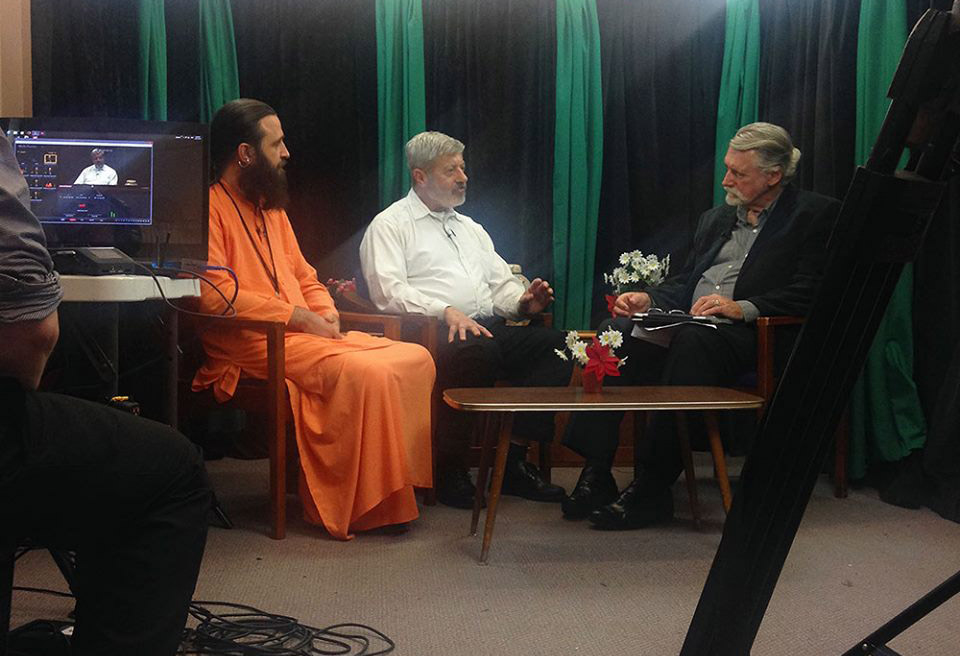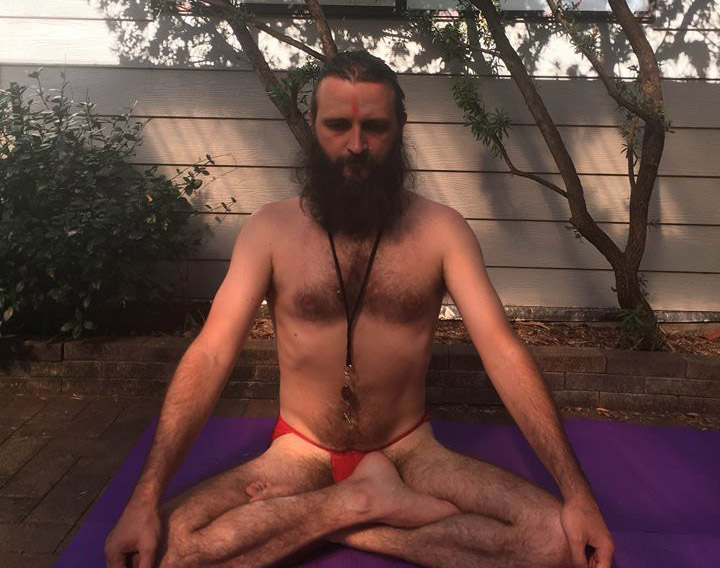This is one of the most interesting sutras, let’s try to examine it.
तत्प्रितषेधाथर्मेकतत्त्वाभ्यासः॥३२॥ tatpratiṣedhārthamekatattvābhyāsaḥ || 32 ||
तत् tat – that;
प्रितषेध् pratiṣedh (प्रित – backwards, षेध् от सिध् – taking away) – holding up;
अतर्म् artam – goal;
एक, eka – one;
तत्त्व, tattva – essence (thatness) अभ्यासः,
abhyāsaḥ (अभी – in the direction + आस – to the goal) – practise.
In order to control (hold up) them, one must practice concentrating on single entity.
‘Controlling them’ or ‘holding them up’ means what was discussed in the last sūtra: suffering – ‘duḥkha’, depression – “daumanasya“, body trembling – “aṅgamejayatva“, shortness or irregularity of breath “śvāsa-praśvāsa” and absent-mindedness or mind-wandering – ‘vikṣepa’. Before the sutra we are examining, there was a description of obstacles in the practice of mind control, followed by a sūtra, describing what helps to control it.
Many controversial comments have been written by modern yoga teachers. And many of them are not without sound arguments, and it is clear that some authors have tried well to investigate the subject, but not all of them, and many generate more questions. However, there are quite a few classic commentaries on it; there is even a huge commentary by Śankarācārya. For instance, he has a controversy with an anonymous opponent, where the Buddhist terminology is used, and it is also found in the comments of Vyāsa and other gurus. Vyāsa uses the term kṣaṇika (instantaneousness, fragmentariness) in the description of absent-minded perception. Hence the obvious parallels with the Buddhist doctrine ‘kṣaṇikavāda’, especially developed in yogācara. I will only describe it in general terms, since this doctrine is also very important for understanding Nātha-yoga. The idea of the variability of all phenomena, and therefore their emptiness, is also at the heart of whole Buddhism. Its essence is that not a single phenomenon in this world has an independent entity.
All phenomena appear and disappear, each phenomenon can be disassembled according to all its various components, and finally, you will not find anything that exists. I.e. at the end – everything is emptiness. Buddhists say that if you are talking about Atman, then it is a kind of independent entity, because Atman is something that contradicts their theory of emptiness. But as I see it, it is not always an attempt to use this point as the basis of practice for them, but often – how to reduce the understanding of Atman to a level lower than it actually is. After all, these empty disputes may well be endless – with the same success the ideologists and political figures of their sampradāyas may contradict themselves. For example, by the mere fact that they say ’we are not those, or these’ – in this way, they already isolate themselves, because everything that is separate is closed. Something which is closed also corresponds to the principle of form, and therefore it can also be interpreted as mundane. In any case, if we return to Patañjali and classic, famous commentaries on him by Indian gurus – he generally speaks of ātman in connection with ‘ekatattva’ (single entity).
Whatever we study, be it external objects on which we focus our senses, or a content of “karmāśaya” – the causal realm, where our “karmas” are contained (analogy to which is alaya-vijñāna in Buddhism) – in any case, no matter how different or subtle the objects of our awareness are, even to the degree of realising their emptiness, there is someone who is aware of it. So Śankara speaks of ātman, which illuminates them with its light, and Vyāsa speaks about the same. If you look at the Buddhist tantric practices, there are many Deities there, however, by practicing with them, you simultaneously realise their emptiness. And here, personally, I do not see any contradictions with the fact that you would realise them as one with ātman. In his comments, Satyananda Saraswati reasonably condemns many tantrics, who give a lot of initiations with various practices. He says that it is better to practice one thing, otherwise a person will be confused. I agree that for a Westerner, loaded with the duality of the Abrahamic religions, the confusion is 99% guaranteed, except in the rarest cases. These are the cases when a person not only understood Hindu Sanātana Dharma, but became extremely sincere in their commitment to it.
But more often we see imitations instead of true commitment to it, even where people wear rudrākṣa, put tilak on them, install mūrtis of Hindu Devatas to show off etc. Frequently it is only business, where precisely that part is showy and artificial and a soul which believes in the same old duality and other values of the West. There are so many reasons why it’s extremely difficult to sincerely accept it, that’s why it is very good to have the guts to admit your own ignorance and even better – to confess to your guru. Only after that a discipleship and sincere communication start. But to admit it not in the sense of “that is who I am and I can do nothing about it and I will never try’ – the light of desire to change shouldn’t fade out.
Only then contradictions will constantly disappear in the process of continuous revolution in your own consciousness, and there will be no problem on what your mind is focused: Gaṇeśa, Śiva, Goddess or all their forms. I would like to draw your attention to a term in that sutra which, generally speaking, points out to ātman as the basis of recollection and concentration of consciousness. The term is ’tattva’ and it is often translated as an ‘entity’, which means very little for the most of people))). Very many practices become clear if you understand it properly. The term tattva consist of tat (that) and suffix tva, which in English is indicated by the ending ‘-ness’, so it can be translated as ‘thatness’. And here, when you see my examples, you will probably remember Buddhist ‘kṣaṇikavāda’. For instance, when I hear about the elements of earth, water, fire, etc., I have different associations. Earth is like black soil, mountains, rocks, etc.
There is a general characteristic of it, for example firmness, but ordinary people do not perceive it as such, but rather ‘look out’ upon something. A person, for example, hears about the theory of five mahābhūtas, saying that water manifests from fire, earth from water, then earth dissolves into water, water in fire, or that fire manifests itself from water, and thinks – how is that possible? How, for example, can fire appear from water? Probably from alcohol, or petroleum, or oil. He begins to think through the prism of the time he lives in and the values of this time, of all the discoveries and inventions made during this period. He starts thinking about cars that use fuel. And this is only one example of a human perception, conditioned by the time frames – the consciousness of the utilitarian consumer.
Unfortunately, all modern “yogis” also think in that way, not realising that traditionally yogis moved away from such perception, that they are yogis precisely because they are far away from being conditioned by temporary factors. That the goal of yoga is clearly not in “sticking” in phenomenality, as for example, in creating a beautiful body. The body which acquired perfection by itself is rather a side effect of the sādhana as a whole. Another example: when you look at the Dancing Śiva statue, you think that Śiva has four hands and he is dancing, or maybe he carries a skull, or lying dead and Kālī stands on him. Then you think: but who is Kālī, and who is their son Gaṇeśa, who suppose to have a head of an elephant, but there are temples where he has a human head.
You think and think: who they are, ‘who is Śiva?’, sometimes you think he has one head, sometimes he has five, and sometimes nine. So who is Śiva? Is he five-faced? Sort of yes, but also he is not. Śiva is Śiva. To understand who Śiva is you need to stop projecting your limited patterns on him, you need to look at him with an empty mind. Instead of silence and contemplation, people have so much noise in their heads. It blocks perception, people want to impose, not perceive. There are so many gurus around and almost no disciples. A disciple and a yogin are the same, that’s why Gorakśanātha calls yogins ‘avadhū’ – the one who is a yogin, the one who is a yoga practitioner and the one who is a disciple.
When a person decides that they ‘know’, their learning and perception process stops. Thatness means that you, for example, look at Śiva and see through your sensitive perception that it is not just some attributes, but that any attribute and his representation in general – is a gateway to another dimension. And the more you see this thatness, the more this dimension becomes all-encompassing, that’s what tattva–anusandhāna (study of tattva) is. To tell the truth, yogins are people who have the spirit of scientists, researchers, with the difference that they are independent from social institutions. Institutionalism with its frames means very little for yogins due to their spiritual evolution, because they understand the limitations of this system. After all, who are scientists? They are individuals, who made some discoveries, but it doesn’t mean that discovered processes never existed before. Thus, yogin is a kind of a ‘free scientist’, discovering something not discovered by others, and that explains some miracles done by those who achieved a huge success in sādhana. In fact, there are no miracles, there is just something that is understandable and explainable for some, but not for others.
Concluding my explanation of this sūtra, I want to point out a very important moment: in fact, all phenomena exist within one single spiritual entity, a higher, all pervading consciousness that some see as ātman, some as Brahman, some as Śiva or Viṣṇu. Every person has this experience to one degree or another; therefore, when we look at an object, it somehow reveals this experience within us. I would say this: the stability of your concentration does not contradict the vividness of perception, and the vividness of perception is connected with sincerity of what you are doing. There is always a certain awe and humility in sincerity, there is no learning, no research spirit, no discipleship and no spiritual process without it. That is why your sincerity, honesty with all the other qualities listed above help to achieve good concentration, and if it is deep, doesn’t matter what object you are concentrated on, you will gain wisdom from everything. This is probably why the next sūtra lists the qualities important for the practice of pure and stable consciousness.








